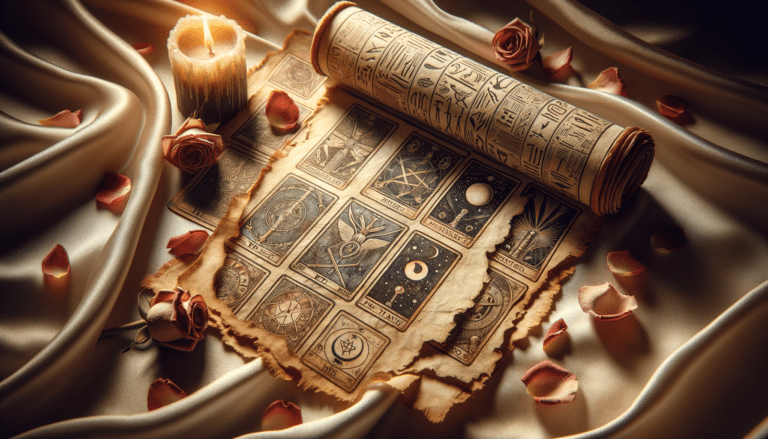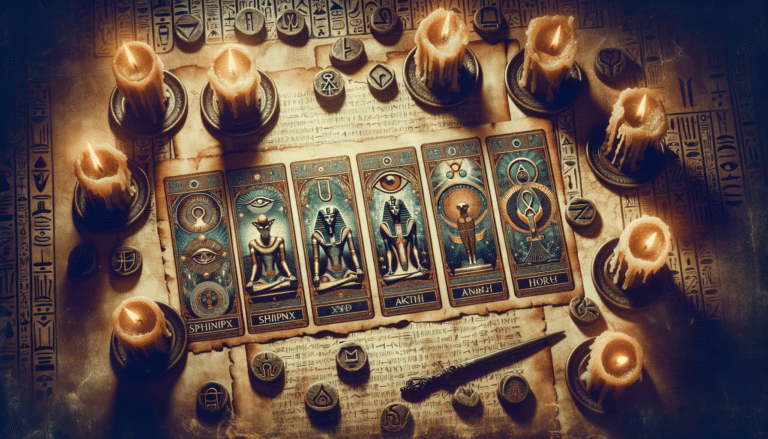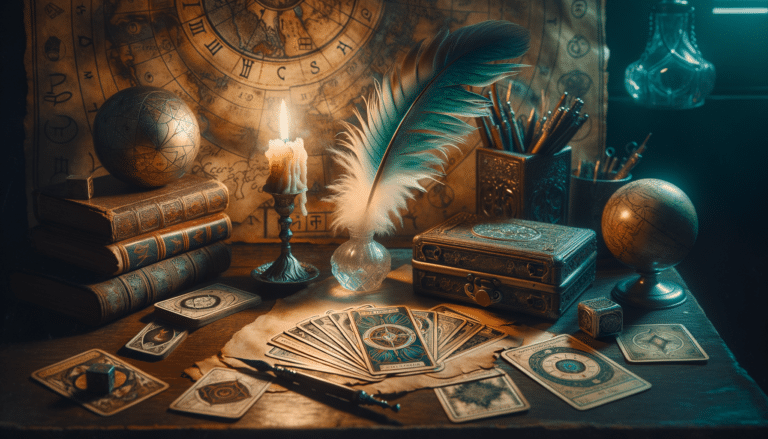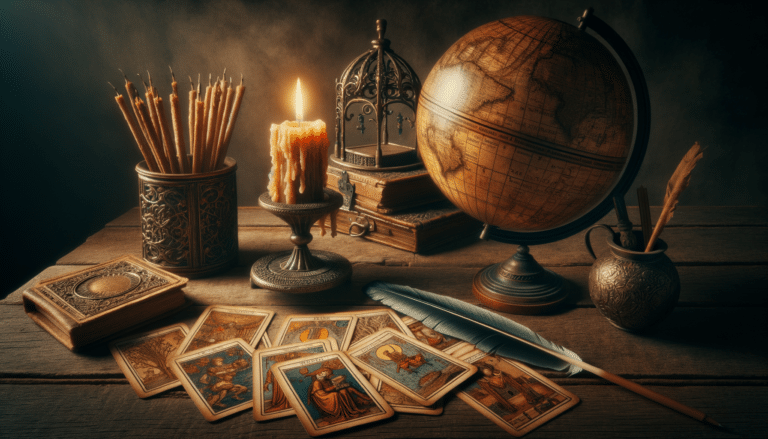Four Key Origins of Tarot Card Reading
Imagine you’re sifting through the sands of time, uncovering the treasures of tarot’s past…
You’ve likely heard of tarot cards as tools for divination, but the origins of tarot card reading are as shrouded as the mysteries they’re said to reveal.
The journey begins with the Mamluk card game, which found its way into European hands in the 14th century and sowed the first seeds of tarot. Then, as the Italian Renaissance bloomed, tarot’s imagery grew rich with symbolic art, reflecting the era’s philosophical and artistic reawakening.
By the 18th century, French occultists, intrigued by the enigmatic nature of the cards, infused them with esoteric meaning – most notably through the works of Court de Gebelin and Etteilla.
Lastly, the Golden Dawn and the Rider-Waite-Smith deck transformed tarot into a tool for personal insight, shaping the modern practice you’re curious about today.
Key Takeaways
- Tarot reading originated from Mamluk card games in medieval Middle Eastern societies and evolved into tarot cards as they traveled to Europe.
- The Italian Renaissance influenced tarot through the Visconti-Sforza Tarocchi decks, which fused mysticism and artistry and set the stage for modern interpretations of tarot.
- The French occult revival reshaped the significance of tarot, with figures like Papus and Eliphas Levi embedding esoteric meaning into tarot and laying the groundwork for modern interpretations.
- Court de Gebelin asserted tarot’s Egyptian origins and sparked enduring fascination with tarot’s potential for ancient knowledge.
The Mamluk Card Connection
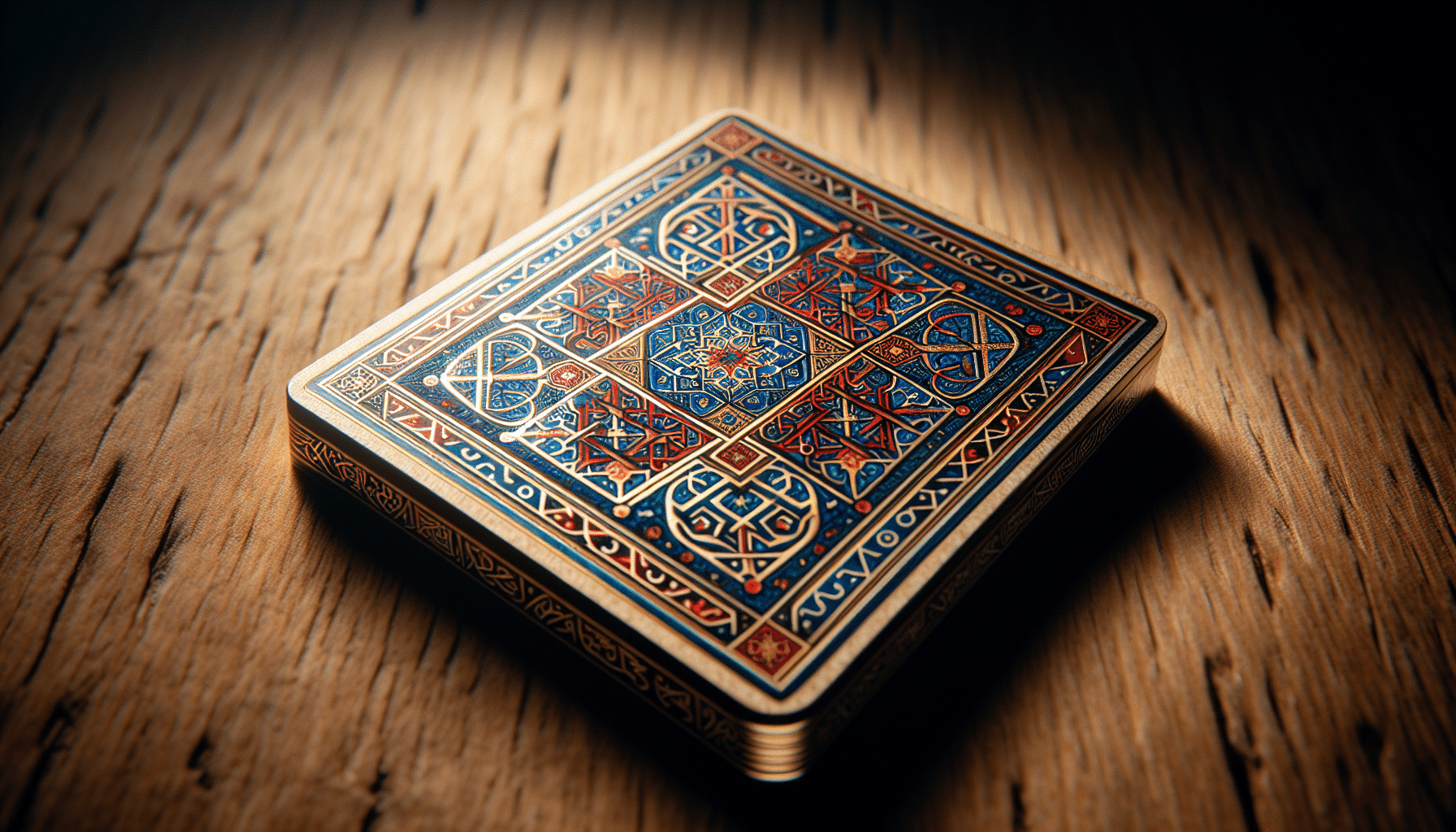
Though you may not be familiar with them, the origins of tarot reading are deeply intertwined with the Mamluk card games that were widespread in medieval Middle Eastern societies. The Mamluk Sultanate, which once reigned from Egypt to Syria, is credited with the inception of these playing cards. You might wonder how a game transforms into a tool for divination. It’s a fascinating journey, one that begins with the intricate and symbolic designs on the Mamluk playing cards.
These cards weren’t simply for play; they were decorated with elaborate motifs and courtly figures, possibly reflecting the social hierarchy of the time. Consider this as you hold a modern tarot deck; the echoes of history are in your hands. The suits and numbers of Mamluk cards bear a resemblance to the tarot’s Minor Arcana, the portion of the deck that deals with everyday matters.
As these playing cards traveled through trade routes to Europe, they morphed into what you know today as tarot cards. It’s not just a matter of leisure but a bridge to the past, connecting you to a long-lost empire through the images and symbols that have traversed time and cultures. So, when you shuffle your deck, you’re shuffling centuries of history along with it.
Italian Renaissance Influence

You’ll find the Italian Renaissance’s fingerprint on tarot through the Visconti-Sforza Tarocchi, a deck rich in symbolism and artistic flair. This era brought a fusion of mysticism and artistry to the cards, setting the stage for modern interpretations.
Let’s explore how these ornate decks weren’t just for play, but also a tool for reflection and divination.
Visconti-Sforza Tarocchi
While delving into the historical tapestry of tarot, you’ll find that the Visconti-Sforza Tarocchi decks, birthed during the Italian Renaissance, are among the earliest and most significant influences on modern tarot reading. Commissioned by the Dukes of Milan, these decks were lavish artworks, reflecting the opulence of the time. Crafted for the noble class, the cards were hand-painted, often embellished with gold and silver, making them treasures of aesthetic and historical value.
You’re witnessing the confluence of artistry and divination as you explore these decks. They’re not just cards; they’re a testament to the human desire to seek meaning beyond the visible, a practice that’s been woven into the fabric of culture for centuries.
Mysticism and Artistry
Exploring the Italian Renaissance’s influence on tarot, you’re tapping into a period where mysticism and artistry richly intertwined to shape the practice’s evolution. The era’s fascination with symbols and allegory seeped into tarot, endowing cards with layers of meaning. The beautiful artwork and iconography of the time bestowed the tarot with its unique character, influencing both divinatory symbols and card interpretations.
| Renaissance Element | Impact on Tarot |
|---|---|
| Allegorical Art | Enhanced Symbolism |
| Humanism | Personalized Readings |
| Neoplatonism | Spiritual Context |
| Hermeticism | Mystical Associations |
As you delve deeper into tarot’s history, you’ll find that each card’s interpretation is not just a guess but a tapestry woven from the period’s rich cultural threads.
Check out our Tarot Decks here…
French Occult Revival

You can’t explore the history of tarot without acknowledging the French Occult Revival, a period brimming with mystic exploration. Figures like Papus and Eliphas Levi were pivotal, reshaping tarot’s significance and embedding deeper esoteric meaning into its practice.
Their contributions laid the groundwork for the modern interpretations and uses of tarot cards you’re familiar with today.
Papus Influence
As you delve into the history of tarot reading, it’s essential to recognize that Papus, a pivotal figure in the French Occult Revival, significantly reshaped the mystical interpretation of the cards. His biography reveals a man fascinated by the esoteric, dedicating his life to developing divinatory methods and understanding the tarot’s deeper symbolism.
Here’s a brief glimpse into Papus’s influence:
| Aspect | Contribution |
|---|---|
| Papus’s Background | Initiated into occultism, he founded the French occult movement. |
| Divinatory Techniques | Advanced tarot reading as a tool for divination. |
| Legacy | His teachings continue to inspire modern tarot enthusiasts. |
Papus’s work laid the foundation for the tarot’s use in modern spirituality, blending ancient wisdom with turn-of-the-century occult practices.
Eliphas Levi Contributions
During the French Occult Revival, Eliphas Levi’s reinterpretation of tarot symbolism profoundly influenced its modern esoteric usage. You’ll find that Levi’s work bridged the gap between the tarot and the Magical Kabbalah, entwining the cards with deeper, mystical meanings. He saw the tarot images not just as casual divinatory tools but as profound symbols reflecting the secrets of human existence and cosmic principles.
His writings embedded tarot within the broader context of Occult Philosophy, suggesting the cards encoded the laws of the universe and could be used for personal transformation. By aligning the Major Arcana with the Hebrew alphabet, Levi empowered tarot with a structure and depth that hadn’t been acknowledged before, paving the way for the tarot’s integral role in occult practices today.
Learn more with these best tarot books here…
The Role of Court De Gebelin

Delve into how Court de Gebelin set the stage for modern tarot reading by asserting its Egyptian origins in the late 18th century. Antoine Court, known as Court de Gebelin, was a scholar influenced by the Enlightenment’s values yet challenged its skepticism. He firmly believed that tarot cards held ancient wisdom from Egyptian mystics. His ideas were a blend of scholarly curiosity and a desire to uncover a transcendent truth, which resonated with many seeking spiritual guidance beyond the bounds of traditional religion.
Here’s a table summarizing key points of Court de Gebelin’s influence:
| Contribution | Significance |
|---|---|
| Egyptian Origin Theory | Suggested tarot’s mystical roots, captivating imaginations. |
| Enlightenment Context | Merged rational inquiry with esoteric interests. |
| Tarot as a Tool | Paved the way for tarot’s spiritual and divinatory use. |
Court de Gebelin’s work sparked an enduring fascination with tarot’s potential as a conduit for ancient knowledge, shaping how tarot reading is perceived and practiced today. His assertion that tarot cards were more than just games led to a broader acceptance and exploration of tarot as a means for divination, self-reflection, and spiritual connection.
Learn even more secrets of the tarot history here…
Etteilla’s Esoteric Exposition
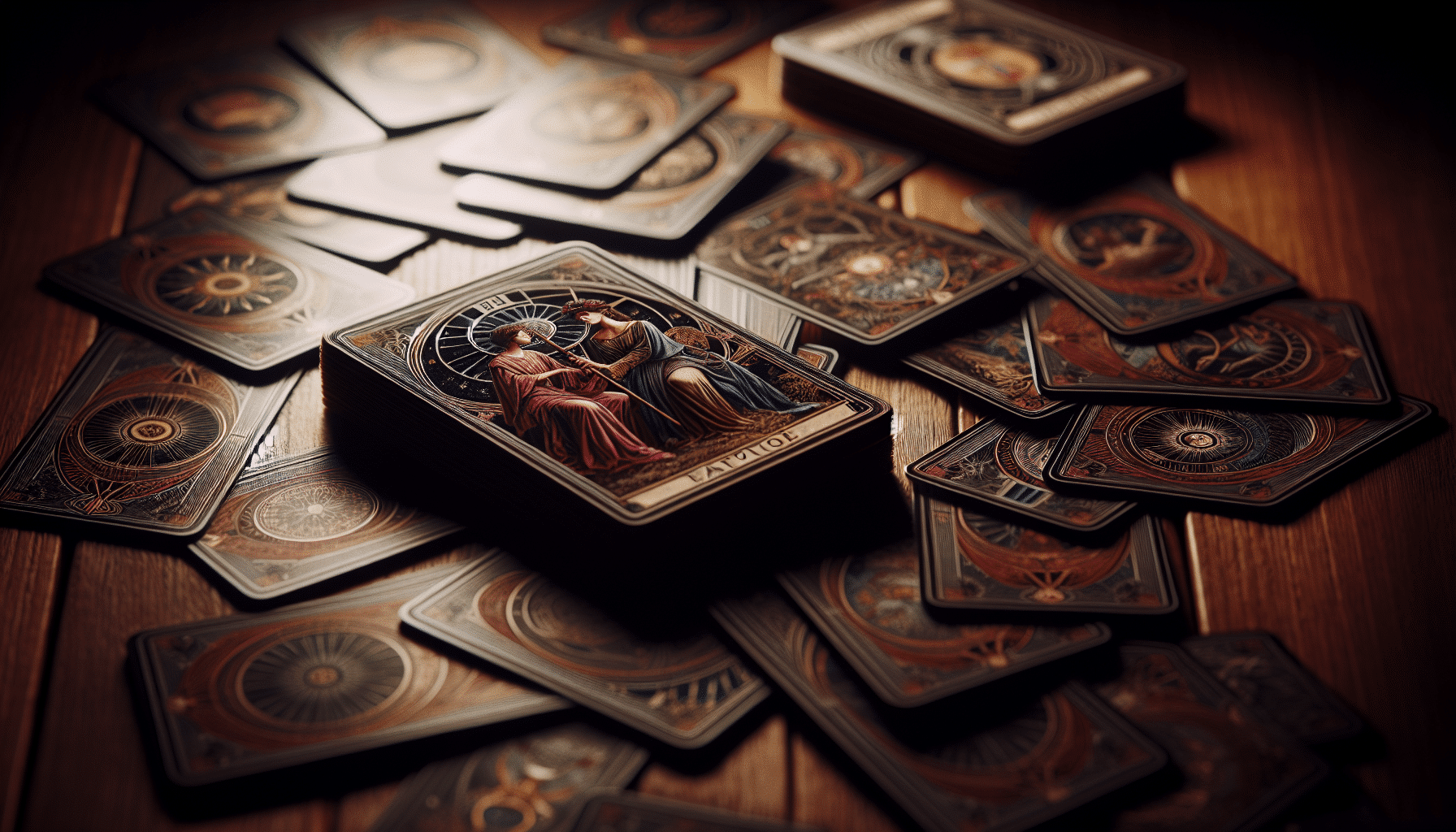
You’ll find that another pivotal figure in the evolution of tarot was Etteilla, a French occultist who was the first to issue a tarot deck specifically designed for divinatory purposes. Born Jean-Baptiste Alliette, Etteilla took his pseudonym by reversing his surname, signaling a new chapter in tarot’s history. He was a seminal force in popularizing tarot divination in the late 18th century.
Etteilla’s esoteric exposition on tarot reading emphasized the importance of esoteric symbolism in the cards. He believed that the images and symbols contained deep mystical truths and were keys to understanding the universe. His approach to tarot was methodical, creating detailed meanings for each card and establishing divination methods that could be taught and followed. This structured interpretation of tarot cards set a new standard for readers.
His legacy includes not just the Etteilla deck, with its intricate esoteric symbolism, but also his comprehensive lists of card meanings and divination methods, which have influenced tarot reading practices immensely. Etteilla’s work made tarot accessible to a broader audience, demystifying the process and establishing a systematic approach that endures in tarot communities to this day.
Golden Dawn Contributions

Building on Etteilla’s structured approach, the Hermetic Order of the Golden Dawn further refined tarot reading with their elaborate rituals and symbolism. This secret society, emerging in the late 19th century, became a cornerstone in the development of modern tarot practices. You’d find that the Golden Dawn’s influence was profound, integrating Occult symbolism and Ceremonial magic into the fabric of tarot.
Their work created a rich tapestry of meaning and purpose behind each card, transforming tarot from a simple parlor game into a complex tool for divination and personal insight. The Order’s members, including notable figures like Arthur Edward Waite and Aleister Crowley, contributed significantly to the esoteric knowledge associated with the cards.
Here’s how the Hermetic Order of the Golden Dawn influenced tarot:
-
Complex Symbolic Framework: Each card was attributed with astrological, elemental, and Hebrew letter correspondences.
-
Ceremonial Magic Practices: Members used tarot within magical rituals, believing the cards could influence the physical world.
-
Mystical Pathworking: Tarot served as a map for spiritual and psychological development, guiding initiates through mystical journeys.
As you delve into tarot, you’ll encounter these profound contributions, which continue to shape readings and interpretations to this day.
Rider-Waite-Smith Revolution

The Rider-Waite-Smith deck revolutionized tarot readings by introducing pictorial imagery to the Minor Arcana, allowing you to glean more intuitive interpretations. Before this innovation, the Minor Arcana cards resembled a regular deck of playing cards, with little to engage your imagination.
At the heart of this transformation was the Smith Waite collaboration. In the early 20th century, A.E. Waite, a scholarly mystic, joined forces with artist Pamela Colman Smith. Their partnership aimed to infuse the tarot with rich, accessible symbolism. Waite provided the esoteric knowledge, while Smith brought the cards to life with her evocative illustrations.
Each card in the Rider-Waite-Smith deck teems with tarot symbolism, offering a visual narrative that speaks to your subconscious. You’re no longer just interpreting abstract concepts; you’re engaging with images that suggest stories and emotions. This deck set the standard for modern tarot readings, making the practice more approachable for you and countless others seeking insight.
Thanks to the Rider-Waite-Smith deck, you have a powerful tool at your fingertips. It’s more than just fortunetelling; it’s a way to explore the depth of your own psyche through the universal language of symbols.
Modern Tarot Evolution
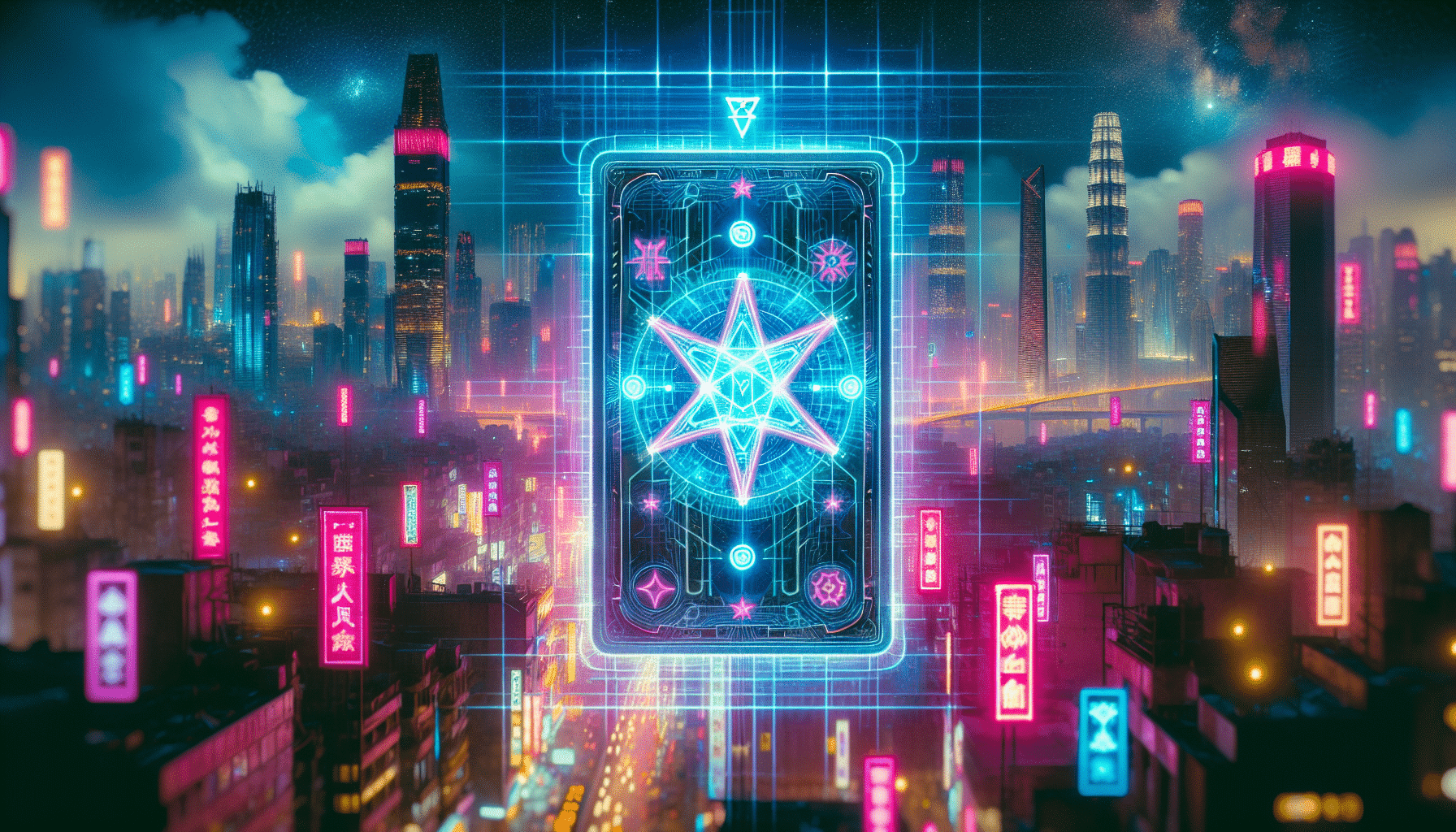
How has the tarot continued to evolve since the Rider-Waite-Smith deck’s introduction? You’ve witnessed the emergence of countless new decks, each bringing its own unique twist to card symbolism and divination practices. Artists and tarot enthusiasts have expanded the visual language of the cards, infusing them with contemporary themes and diverse cultural perspectives. This evolution reflects not just a change in aesthetics but a deeper engagement with the cards’ meanings.
The modern tarot landscape is diverse, with decks designed to resonate with different users’ identities and spiritualities. You’ll find decks that honor various traditions, mythologies, and artistic movements, making the tarot more accessible and personal than ever before. The symbology within these cards has become a rich tapestry, reflecting the complex world you live in.
Here’s what you need to know about the ongoing evolution of tarot:
- Inclusivity: New decks embrace a spectrum of genders, ethnicities, and cultures, promoting a broader representation.
- Technology: Digital tarot decks and online readings have democratized divination, making it more accessible.
- Psychology: Some modern decks incorporate psychological concepts, aligning card symbolism with therapeutic practices.
As you delve into modern tarot, remember that it’s a living tradition, continually shaped by the people who use and love the cards.
Conclusion
As you’ve traced tarot’s labyrinthine path through history, you’ve seen it transform from simple playing cards to a complex mirror of the soul.
Like a tree whose roots delve deep into varied soils of cultures and epochs, tarot’s branches now spread wide, offering shade and mystic insight to all who seek its shelter.
Embrace its rich tapestry of symbols and continue to weave your own stories into the ever-evolving tapestry of tarot reading.
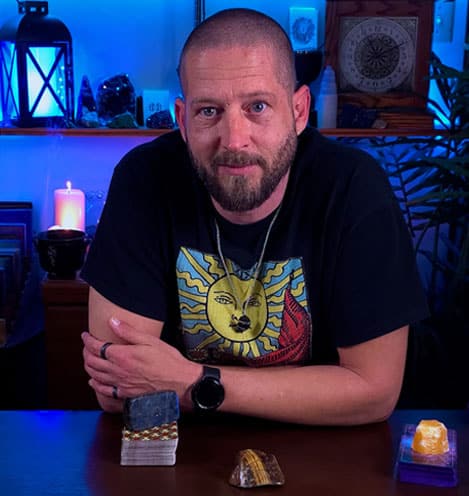
About The Author – Allen Hill
Allen Hill, the force behind Unknown Truth Tarot, has a YouTube following 6-times bigger than the population of his hometown, Miamisburg, Ohio. From his spiritually rich blog on Tarot and crystals to his role as CEO of The Unknown Truth Tarot Metaphysical Shop, Allen’s passion for the metaphysical shines through.
A master Tarot reader and “crystal junkie,” Allen is also a devoted dad to Dylan, 10, and Destiny, 24. When he’s not immersed in the world of Tarot and crystals, he enjoys poker and video gaming sessions, often humorously outplayed by Dylan.
Follow Allen on Twitter, Instagram, Facebook, TikTok, and subscribe to his Unknown Truth Tarot YouTube channel to join him on a journey of spiritual growth and self-discovery.

